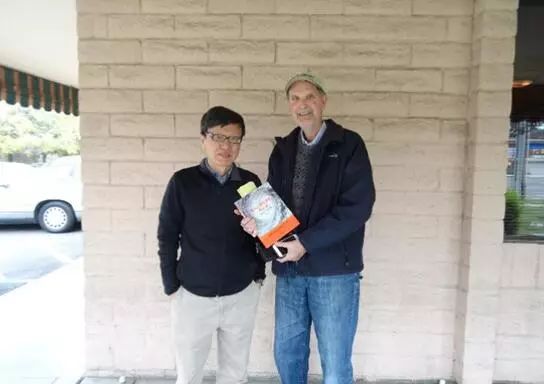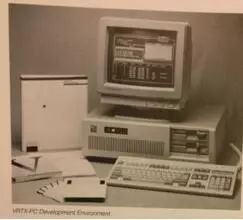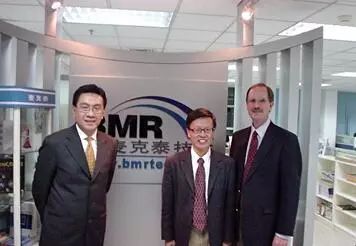
On Christmas Eve 2017, my old friend Andre Kobel wrote to me with some unfortunate news that Jim Ready had passed away. He knew I was visiting the US at the time and asked if my schedule would allow me to attend the memorial service. This news was truly shocking! I had seen Jim at the end of 2016 and presented him with my new book, “Chronicles of Embedded Operating Systems,” thanking him for writing the foreword (see Figure 1). He was very pleased, and we discussed plans to translate this book into English. Little did I expect that just a year later, Jim would be gone.

Figure 1: In 2016 with Jim Ready in Cupertino, Silicon Valley
After Christmas, with arrangements made by Jim’s family, a few close friends and I attended a memorial service held at the Simon Church in Los Altos. As one of Jim’s friends said during the service: “Although Jim did not become a giant entrepreneur in Silicon Valley, he was a true model of a Silicon Valley entrepreneur and the father of embedded Linux.” Losing a dear friend of 20 years is truly heartbreaking! May Jim rest in peace!
The Pioneer of Commercial RTOS
In 1980, Jim Ready co-founded Hunter & Ready with Colin Hunter, which later became Ready Systems. Jim developed VRTX—the world’s first commercial RTOS. VRTX stands for Versatile Real-Time Executive, a multifunctional real-time kernel. VRTX set a standard in the industry by providing a real-time kernel for specific microprocessors in the form of a binary code library, offering APIs for user development, and charging licensing fees to chip companies or end users. Years later, successful commercial RTOS products in the market, including ISI’s pSOS in the mid-1980s and Wind River’s VxWorks in the 1990s, adopted the model established by Jim. VxWorks was even called VRTX Works because it was initially built on the VRTX kernel, adding TCP/IP protocols, file systems, and compilation and debugging tools to support more complex applications.
The initial version of VRTX was VRTX32. In the early 1990s, Microtec Research acquired Ready Systems, and the VRTX kernel was upgraded to VRTXsa, which was one of the earliest microkernel RTOS in the industry. In the late 1990s, Mentor Graphics acquired Microtec Research and launched VRTXmc, which, as the name suggests, supported SoC chips and was successfully applied by Motorola in mobile phones. By the late 1990s, VRTX gradually withdrew from the embedded market, but Jim Ready’s status as the pioneer of commercial RTOS remained unshaken.

Figure 2: VRTX Development System
The Father of Embedded Linux
In the late 1990s, Jim quietly kept an eye on a rising new technology and market: open-source Linux. I remember once when we were at Jim’s house for a gathering, he handed me a Linux OS CD and suggested that I pay attention to this new technology and market trend, but unfortunately, I did not take it seriously and set it aside when I returned home.
Jim foresaw that open-source Linux was the future direction and that embedded systems would inevitably use Linux. Positioning himself in the embedded Linux platform, Jim began his second venture by founding MontaVista Software in 1999, with the first product named Hard Hat Linux, a play on words that distinguished it from Red Hat while also indicating its connection to it (see Figure 3). Red Hat is a well-known open-source Linux that pioneered the subscription model for open-source software.

Figure 3: Early Advertisement of MontaVista
Whether it was Hard Hat Linux or the later MontaVista Linux, Jim always adhered to providing technology and services for embedded systems. Hard Hat Linux was the first to implement real-time technology (RT-path) in Linux version 2.4, supporting various embedded processors and single-board computer LSPs and cross-development environments. In the early stages of the startup, Jim achieved great success, with large equipment companies like Motorola, NEC, and Sony adopting MontaVista Linux. Sony invested in MontaVista twice. By 2005, MontaVista had grown to a considerable scale, with over 2000 customers and tens of millions of products sold in the market. However, MontaVista faced difficulties as a 100% open-source company, struggling to find an innovative business model to generate good profits. Coupled with the global financial crisis, MontaVista was acquired by network chip company Cavium in 2009. Coincidentally, that same year, Intel also acquired Wind River, marking the end of a 20-year rivalry between these two embedded OS competitors.
Today, Linux and Android, which is based on the Linux kernel, remain one of the main operating systems for embedded systems. Professionals can see that both commercial and open-source embedded Linux continue to develop following the technological path and business model created by Jim. People refer to Jim as the father of embedded Linux, a title he undoubtedly deserves!
Mentor and Close Friend
Jim was my mentor in the embedded field. In 1992, I attended a real-time technology seminar for the first time, and the speaker was Jim. What impressed me most was Jim’s personal demo, running VRTX on a PC, where the RTscope task debugger could observe task states, which was truly magical! After that, we kept in touch.
When I decided to start my own business in 1994, both Jim and Andre supported my idea. Andre was responsible for international business at Jim’s company, and with their encouragement, a company specializing in embedded software, Beijing Maikete Software Technology Co., Ltd., was soon established.
I was fortunate to follow Jim through his two entrepreneurial journeys. Jim was a mentor to many at Ready Systems (including later Microtec) and MontaVista, as well as my career mentor and a close friend for 20 years. Like me, some friends who worked with Jim continue to pursue careers in embedded software.
In terms of professional skills, Jim was quick-witted and always able to accurately predict industry and technology development trends. In the summer of 2015, I met with Jim in Silicon Valley, where he was the chief technical consultant at Cadence Design Systems. When we discussed Google’s IoT OS (then called Brillo), Jim believed that the IoT OS had more opportunities in the cloud, while the device side lacked a profitable business model. Subsequent developments confirmed Jim’s viewpoint. Alibaba launched AliOS, Microsoft introduced Windows 10 IoT, Huawei developed Lite OS, and Amazon created Amazon FreeRTOS, all prioritizing support for their respective clouds.
Jim was friendly and humorous. Every time we met at company annual meetings, he would greet us, a few colleagues from Asia, with a phrase in our native language, and when he saw us Chinese, he would ask, “Have you eaten?” Jim loved Chinese cuisine, especially Shanghai’s soup dumplings, which he would always order when dining in China.
In the early 1990s, when China’s embedded industry was just emerging, Jim visited China almost every two years, either speaking at technical seminars or visiting major clients and partners with us. With Jim’s support, the Microtec Chengdu University of Electronic Science and Technology Joint Laboratory was established in 1998, which was a pioneering effort in the country.
After founding MontaVista, Jim’s busy work schedule meant he visited China less frequently, but he was very supportive of the development of Linux in China. With Jim’s support, the MontaVista Linux Beijing Research Center was officially established in 2004, which was also a pioneer among international open-source software companies, and the engineers at the research center later became the backbone of open-source enterprises (see Figure 4).

Figure 4: Jim with MontaVista’s Asia Pacific President Raymond during a visit to BMR in 2003
For 20 years, I have listened to Jim’s teachings and followed in his footsteps. I grew from an engineer, a young person with only a superficial understanding of embedded software and OS, into an embedded systems expert, entrepreneur, and educator. It is my pride to share the knowledge and experiences I learned from Jim, his companies, and friends with domestic colleagues and the industry. I am still engaged in the work that Jim dedicated his life to, focusing on the education and promotion of open-source RTOS and IoT OS. I believe Jim would be very happy!
Jim, may you rest in peace!

1. The second issue of 2018’s “Microcontroller and Embedded System Applications” electronic journal is freshly released!
2. Is hardware unfathomable? These foundational knowledge must be mastered
3. The difficult journey of electric vehicle development seen through three major anxieties!
4. The reasons for the short technical lifespan of Chinese engineers: “Older engineers” equate to industry failures?
5. After the adjustment period of chip companies, the embedded industry will flourish in 2018!
6. Farewell to the C language
